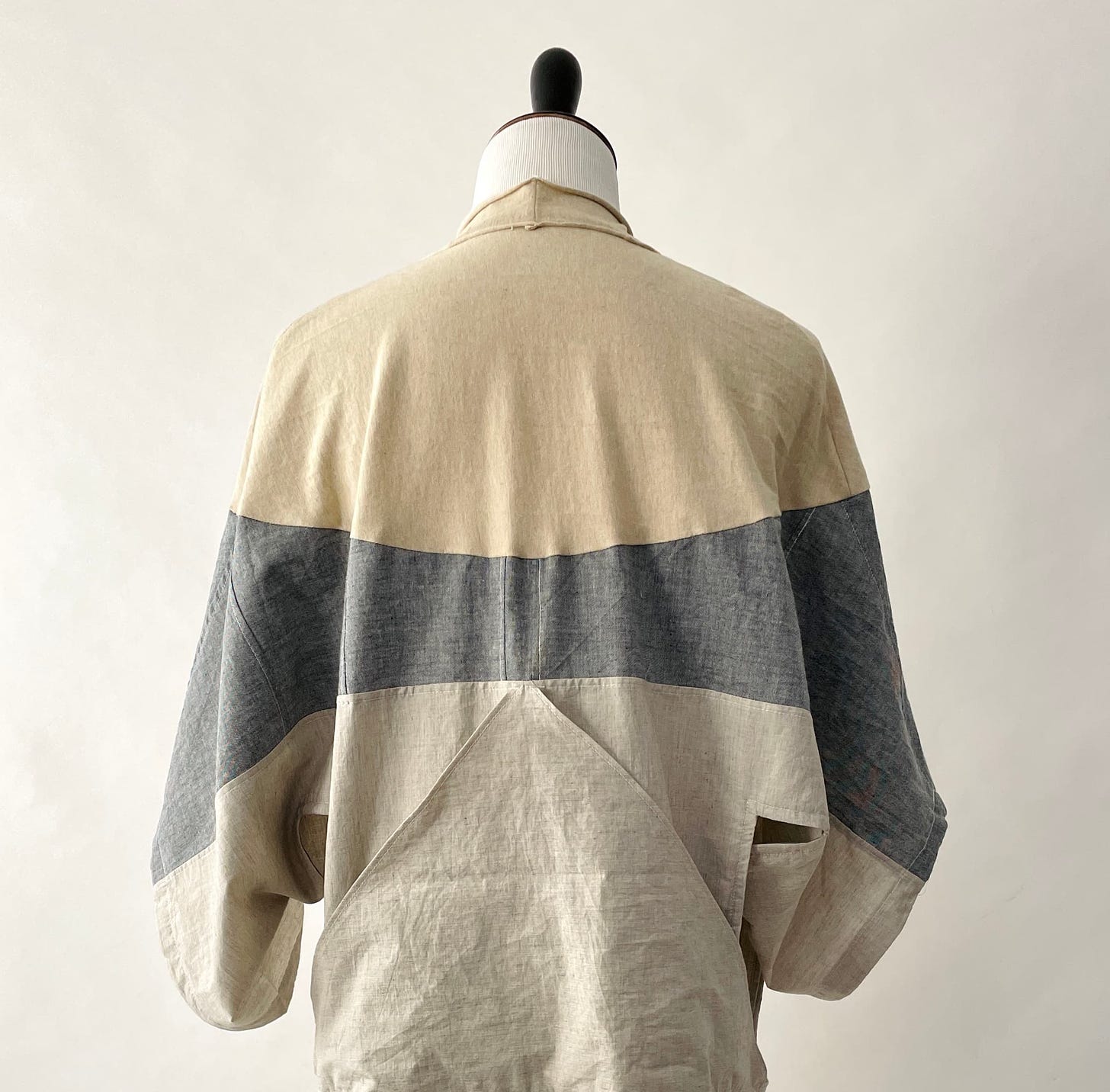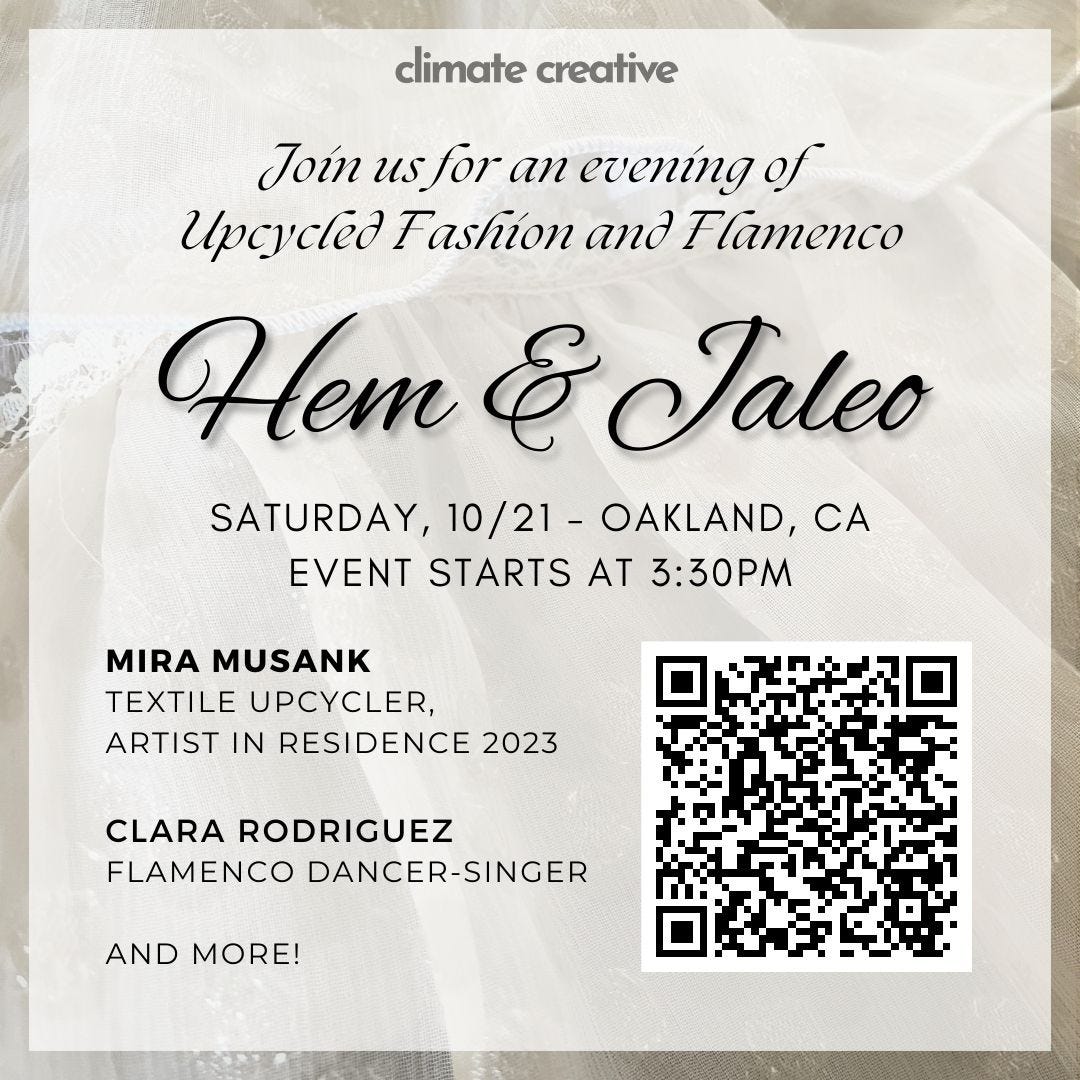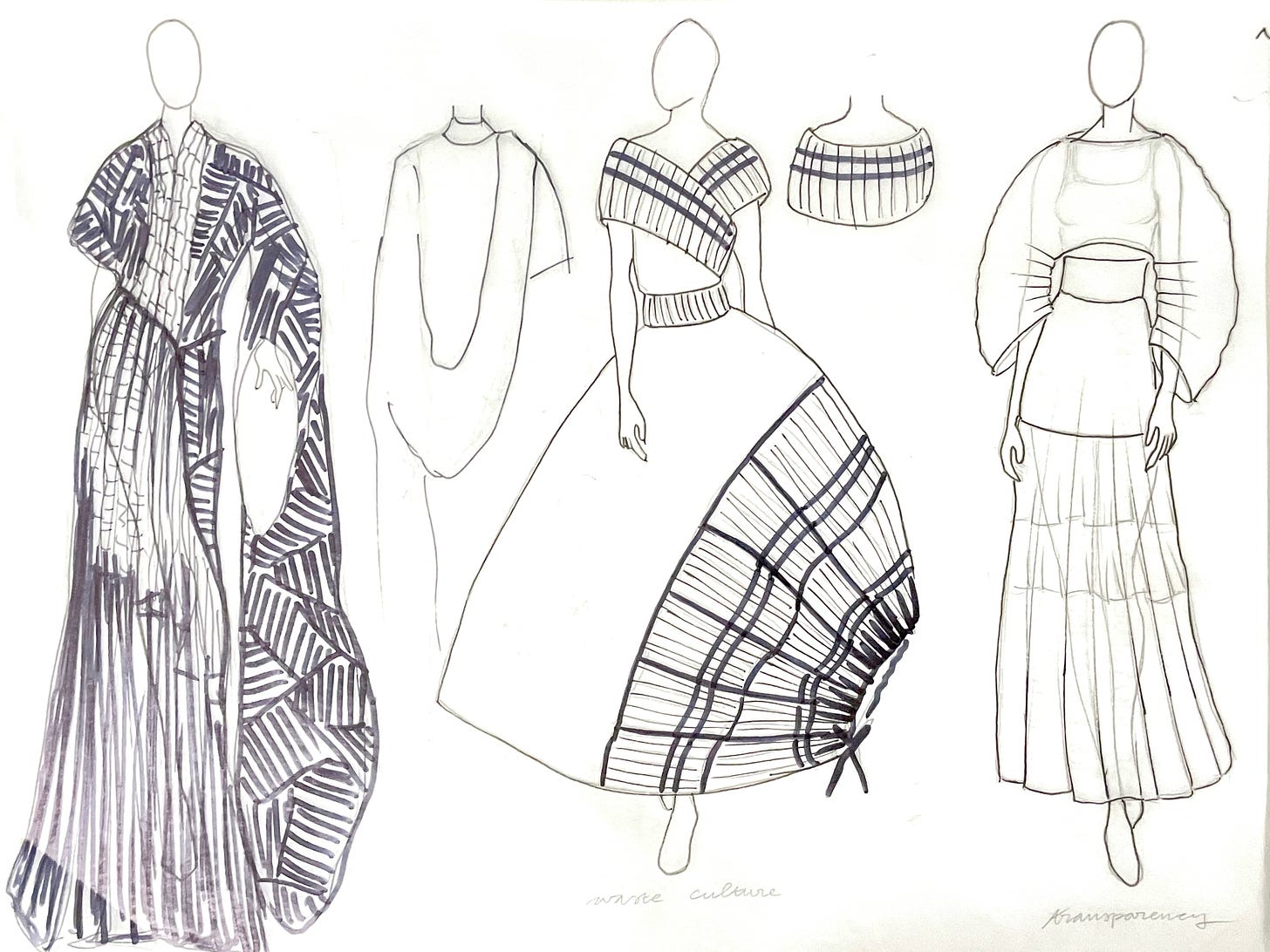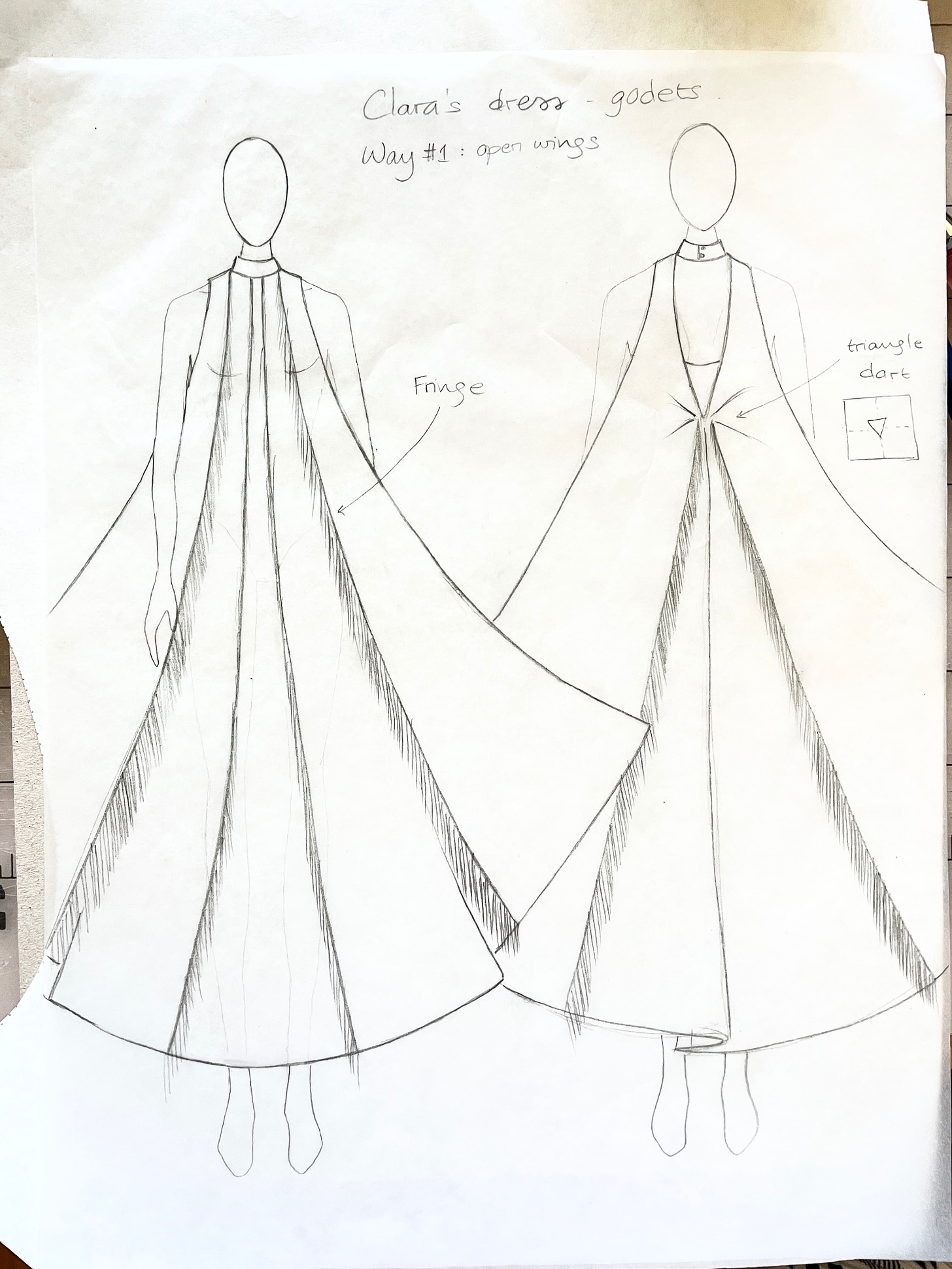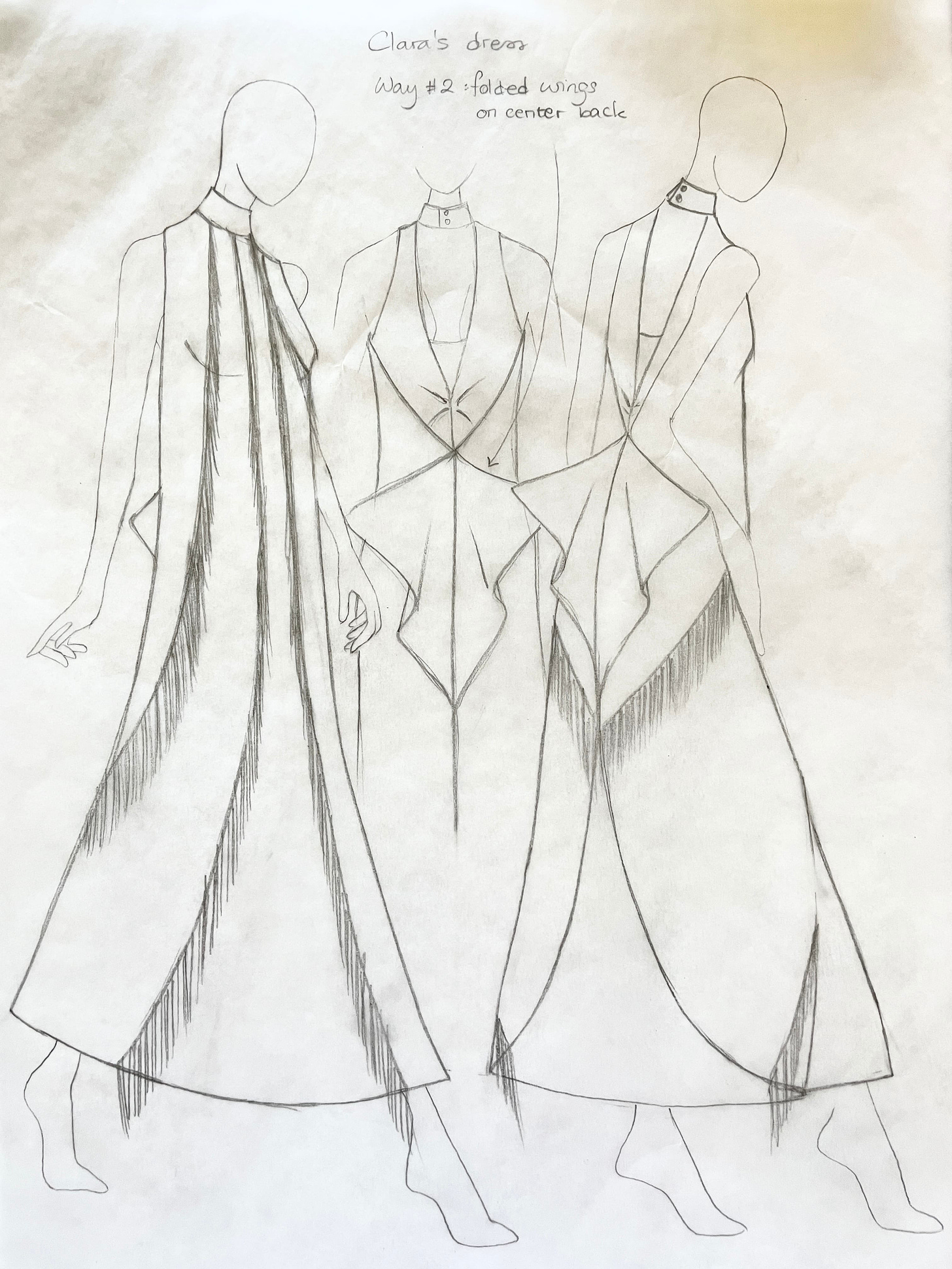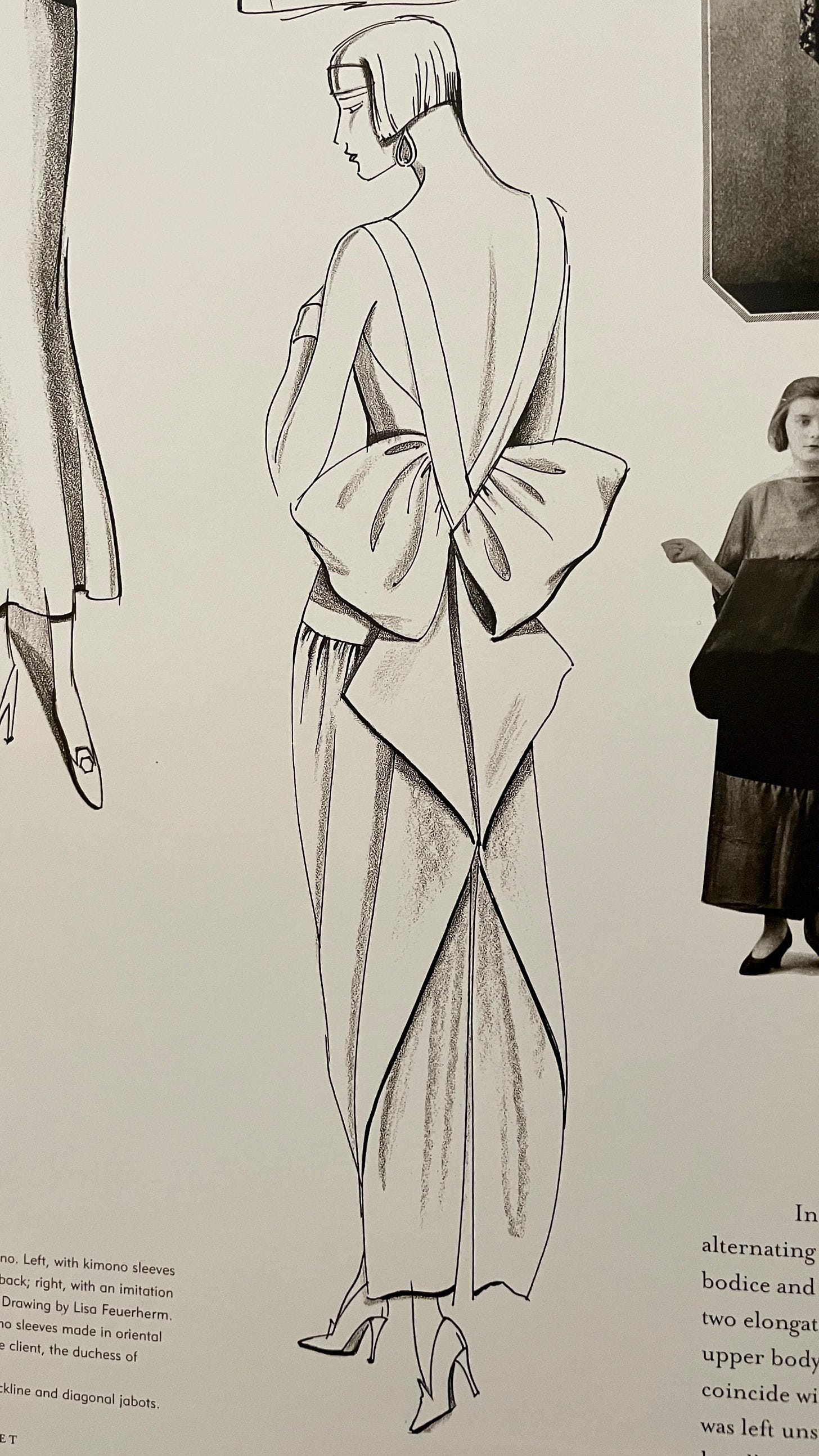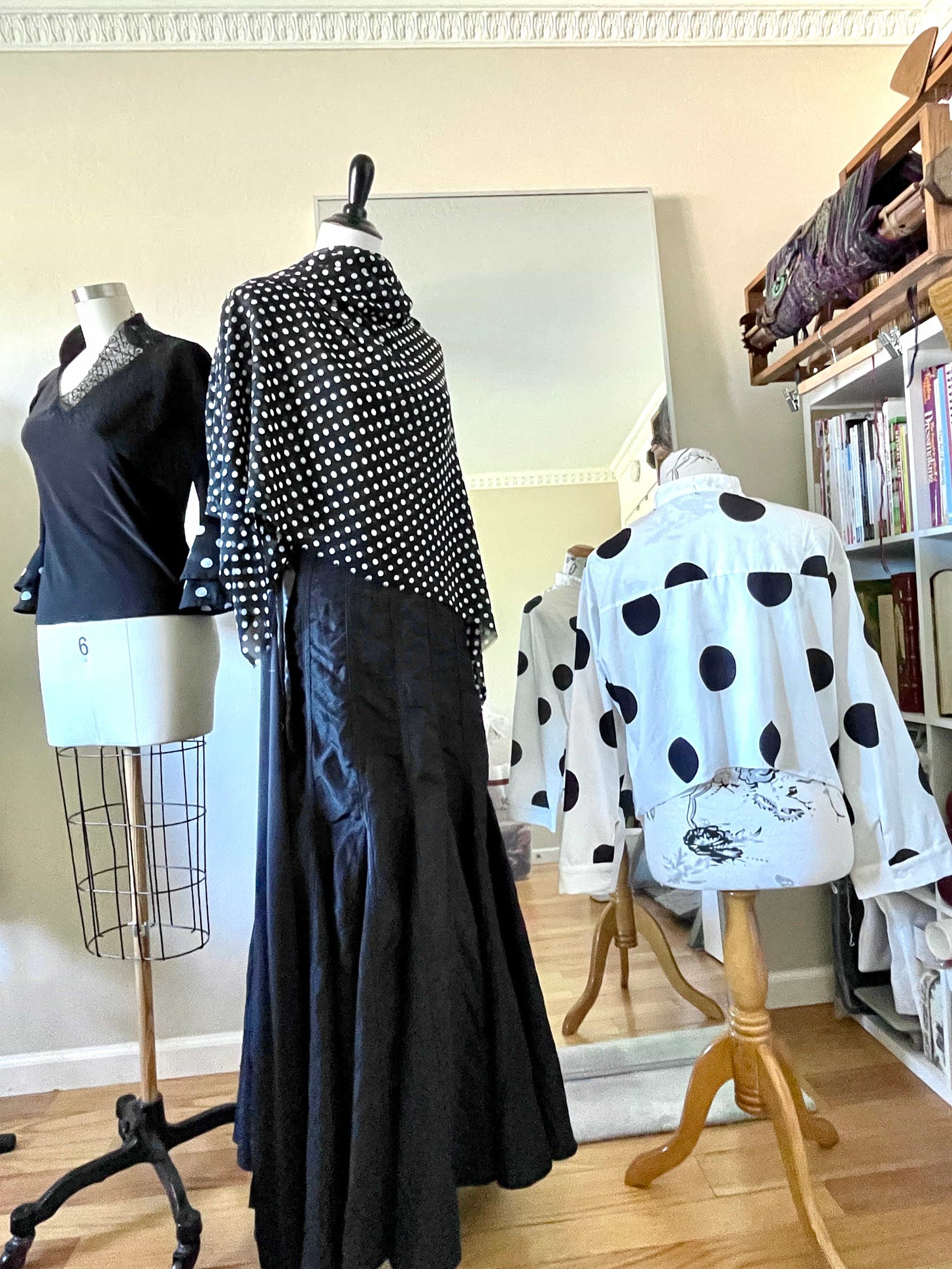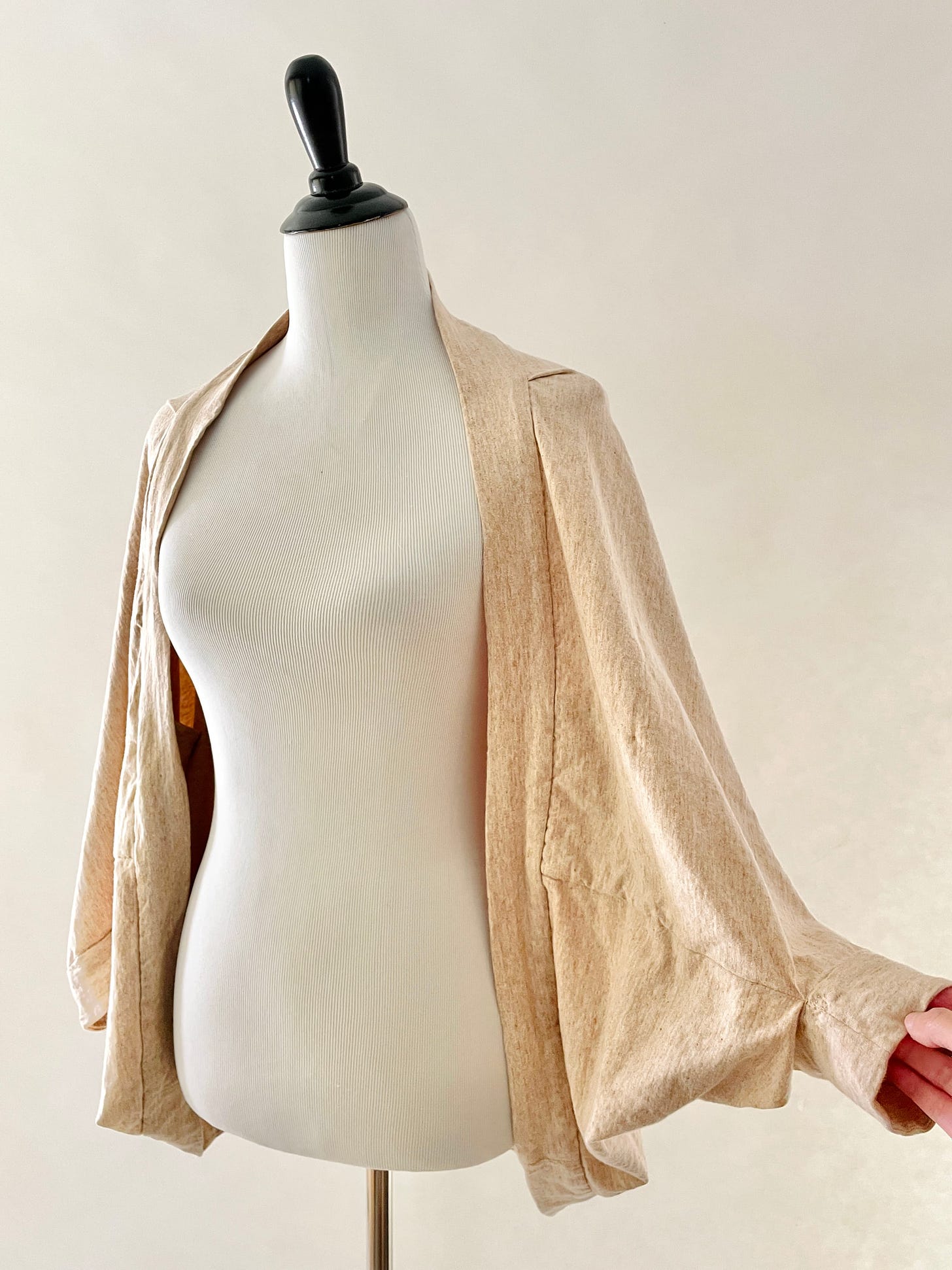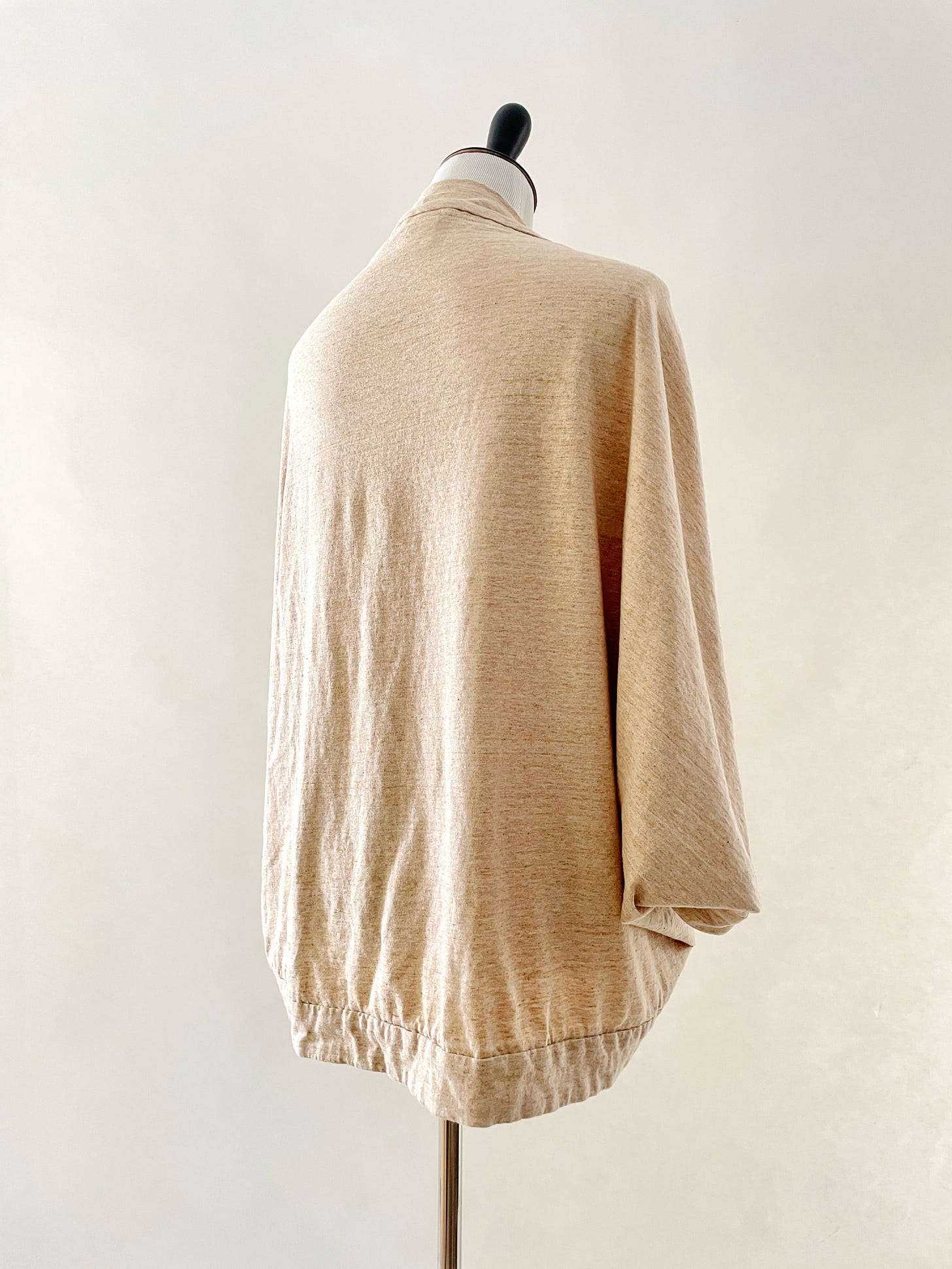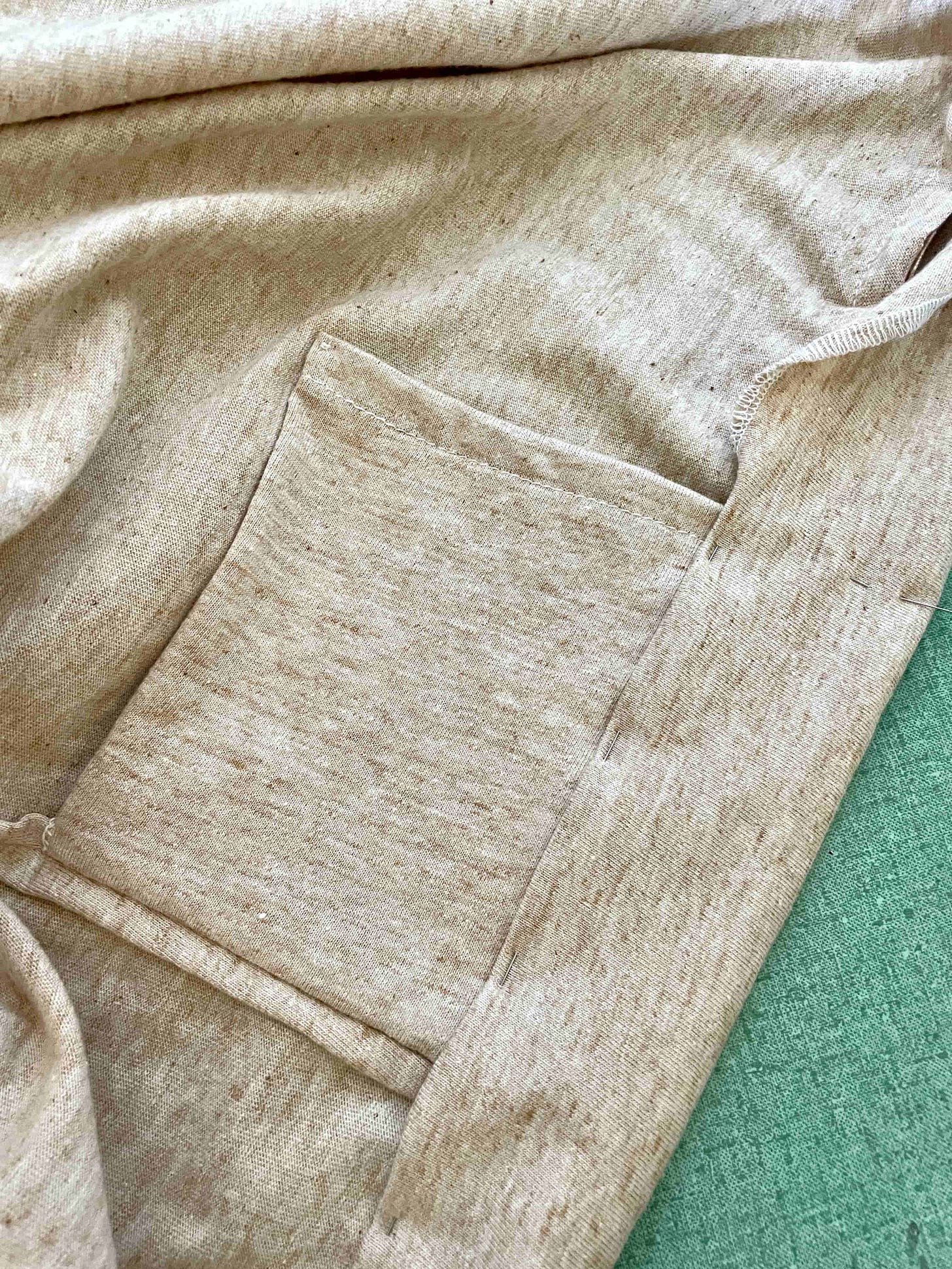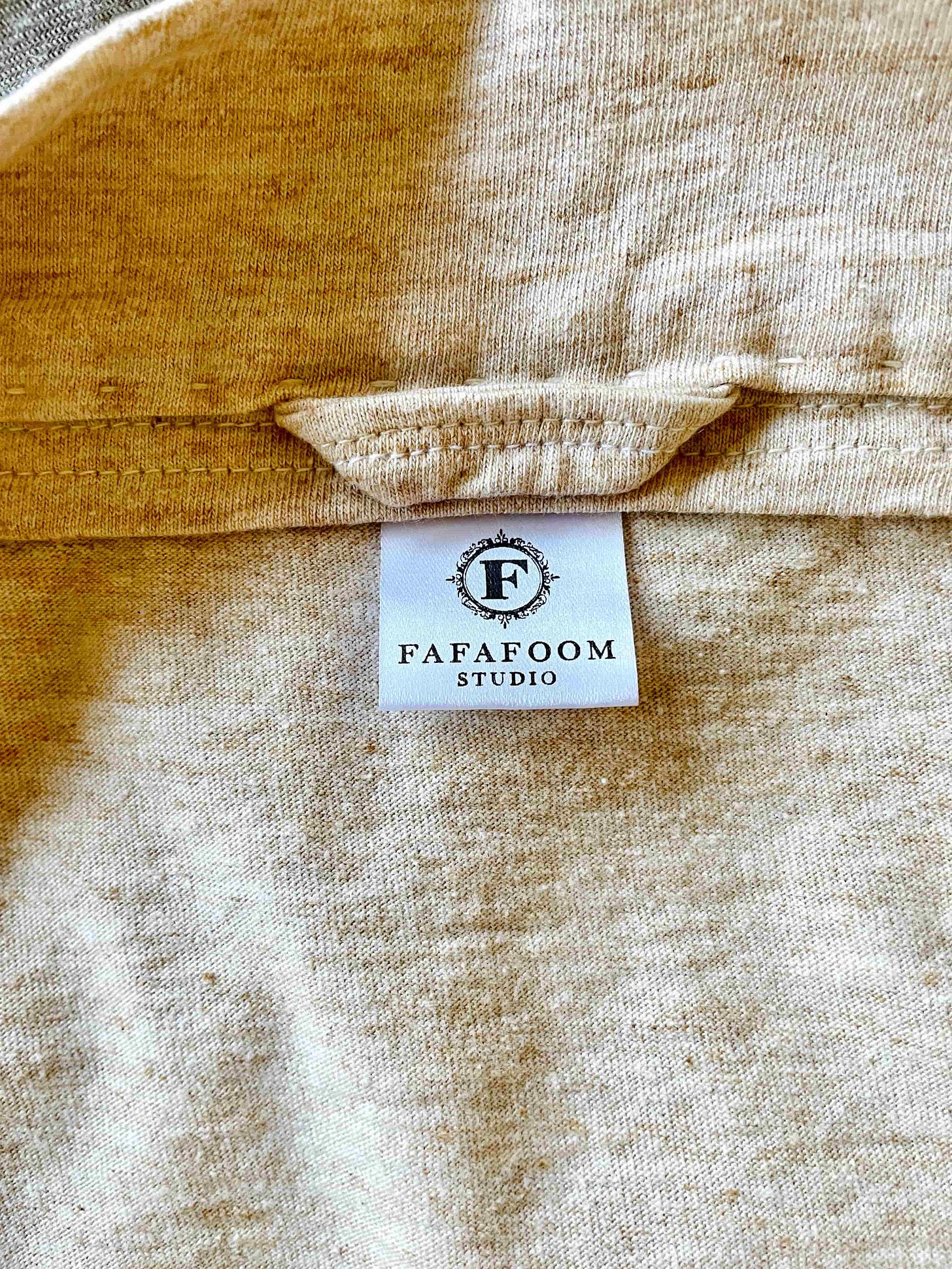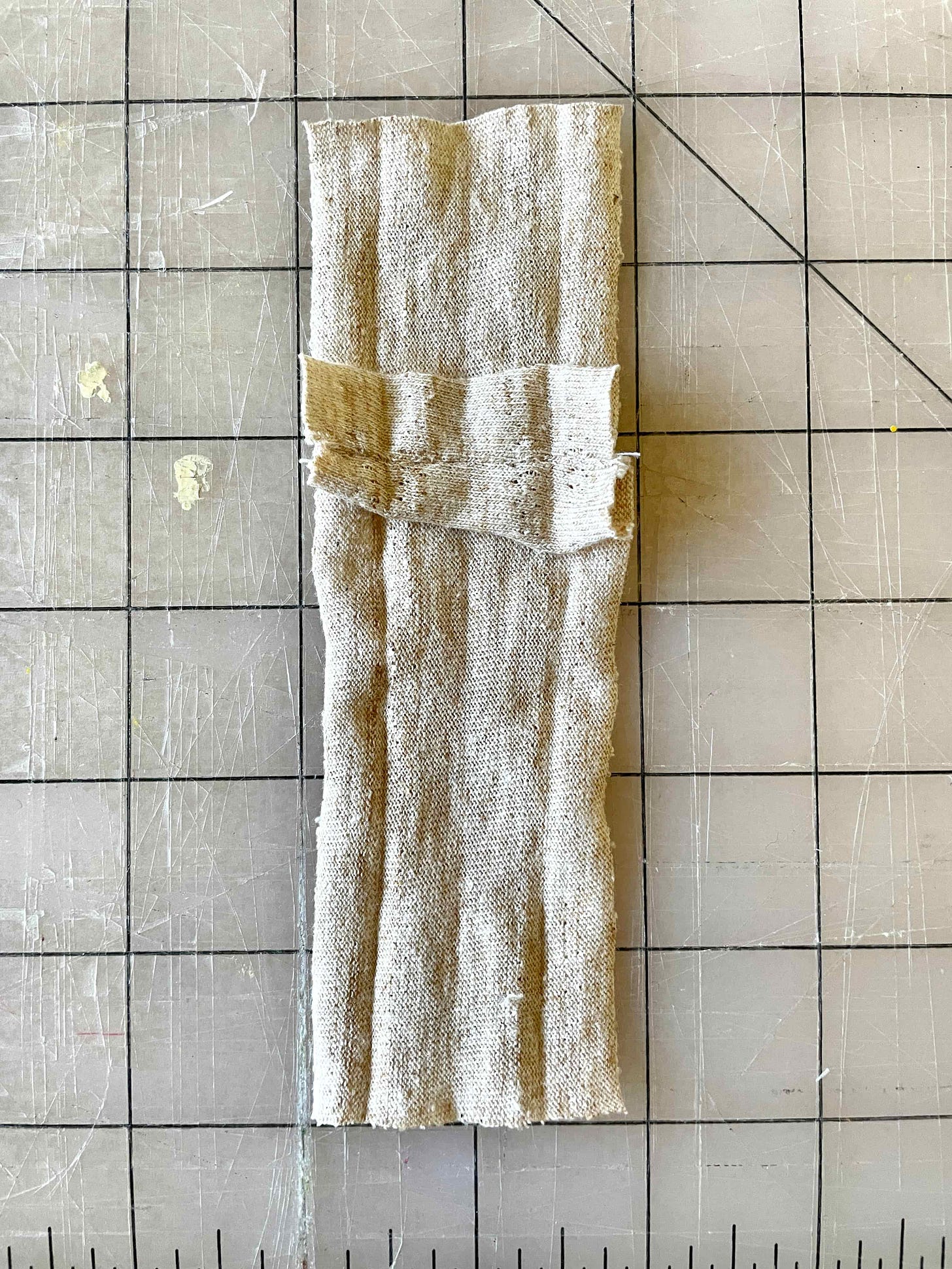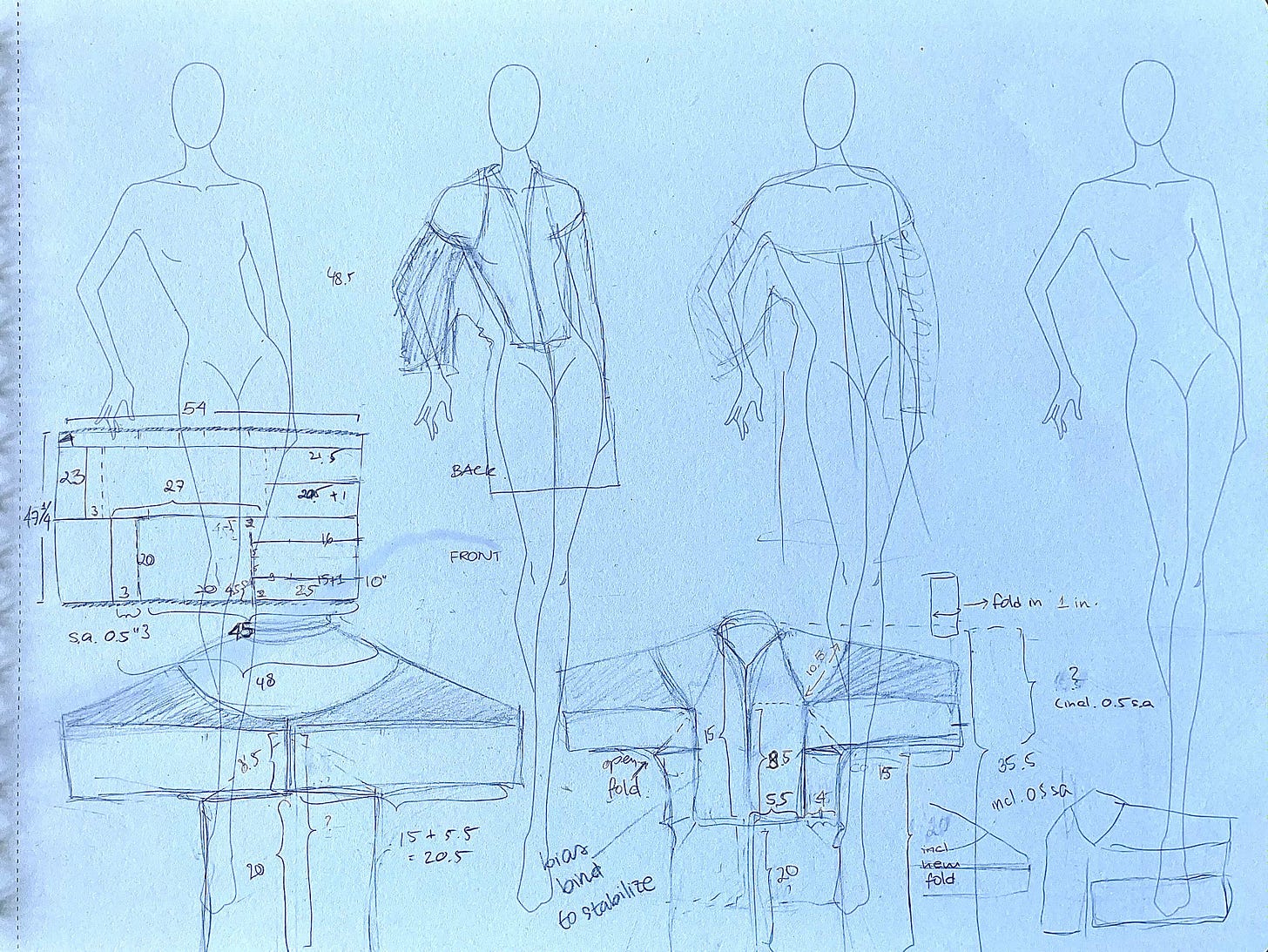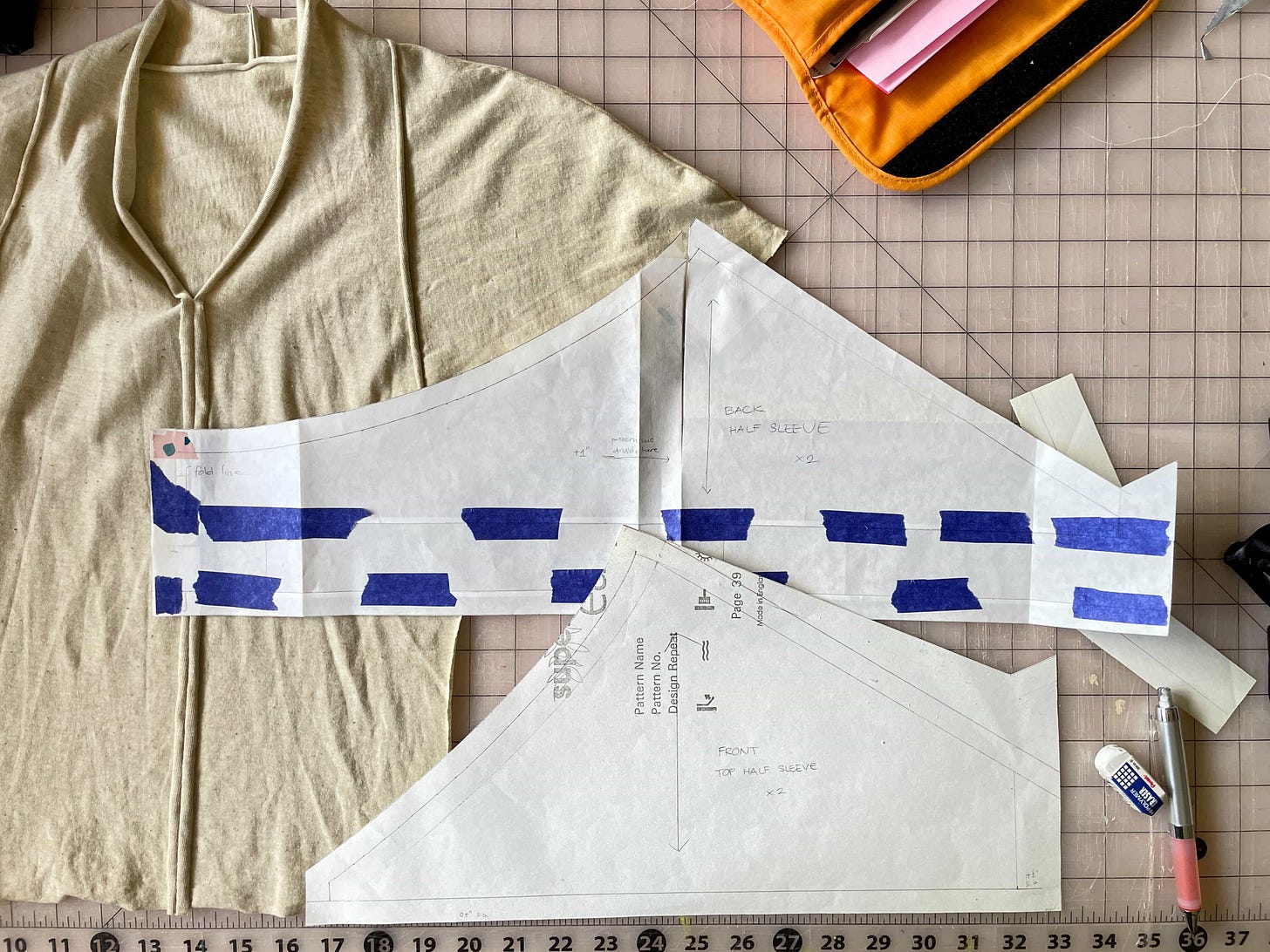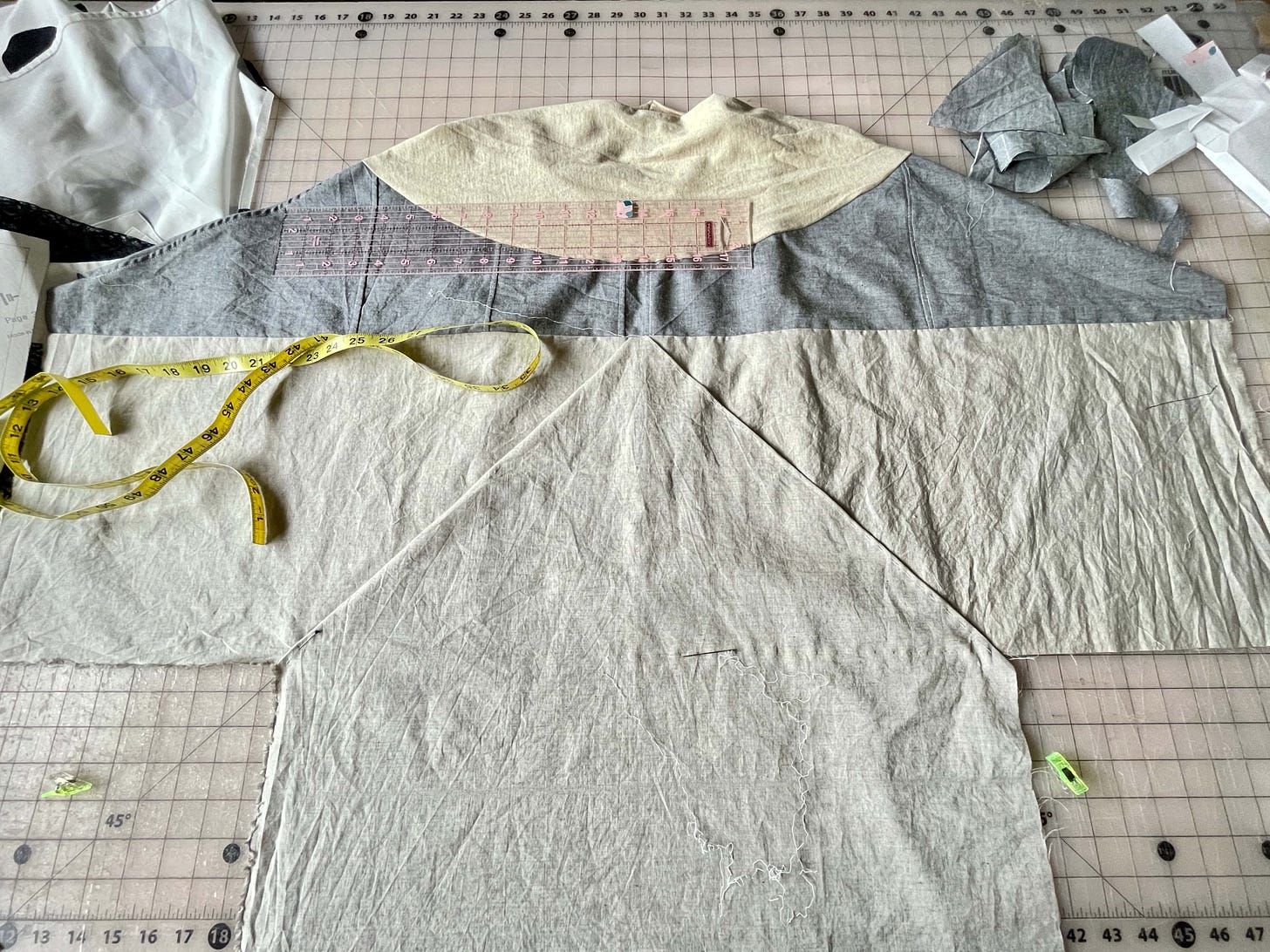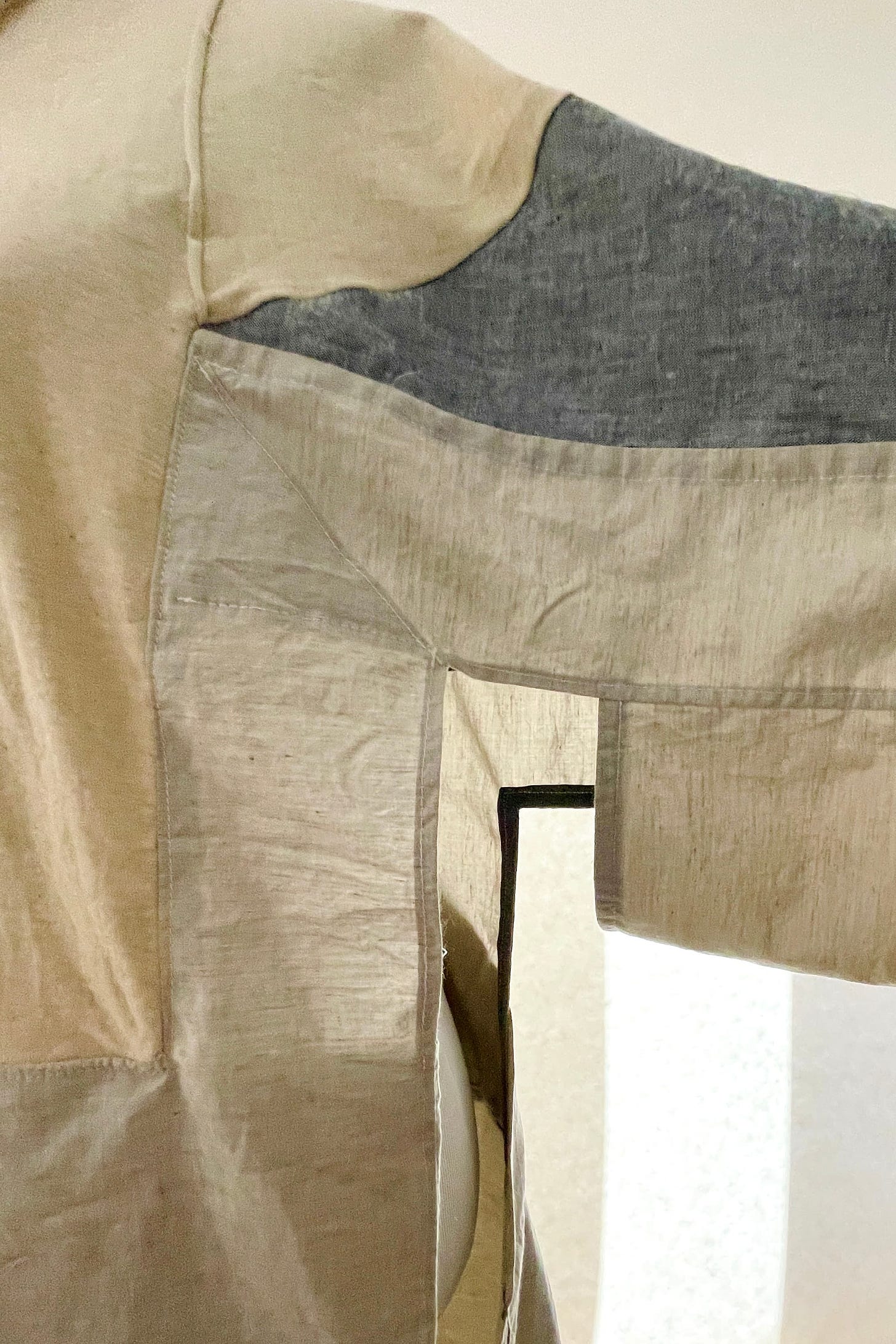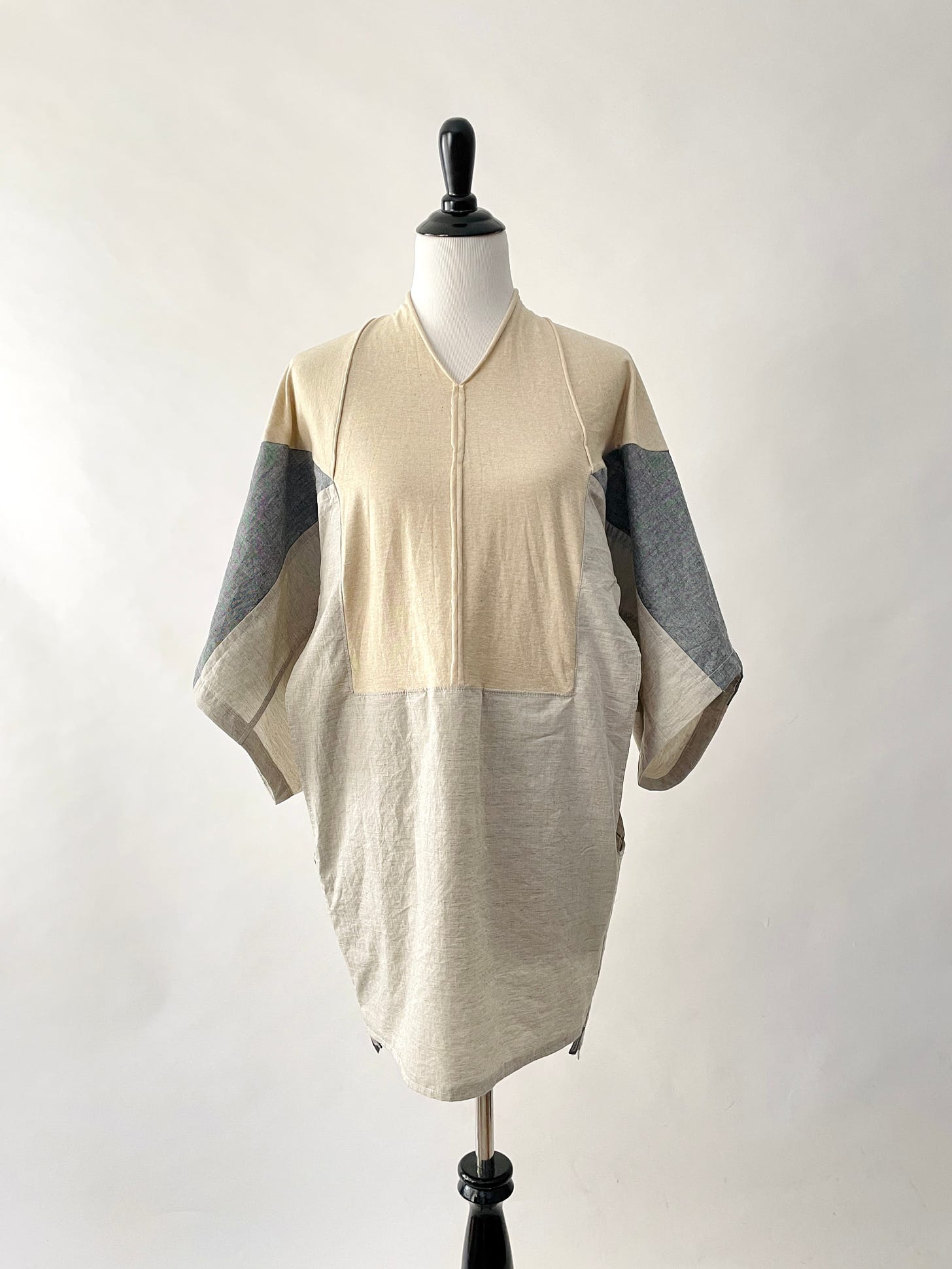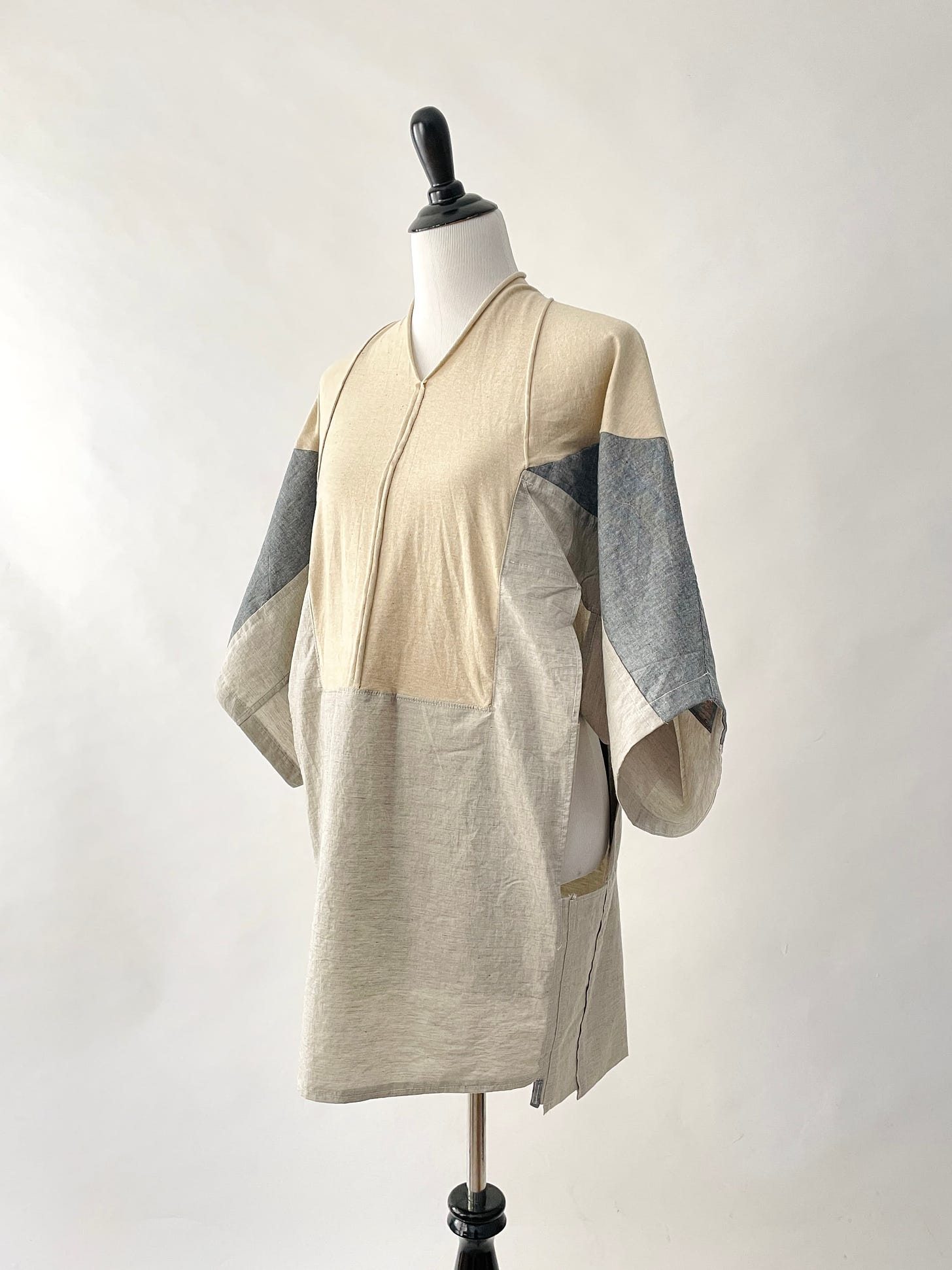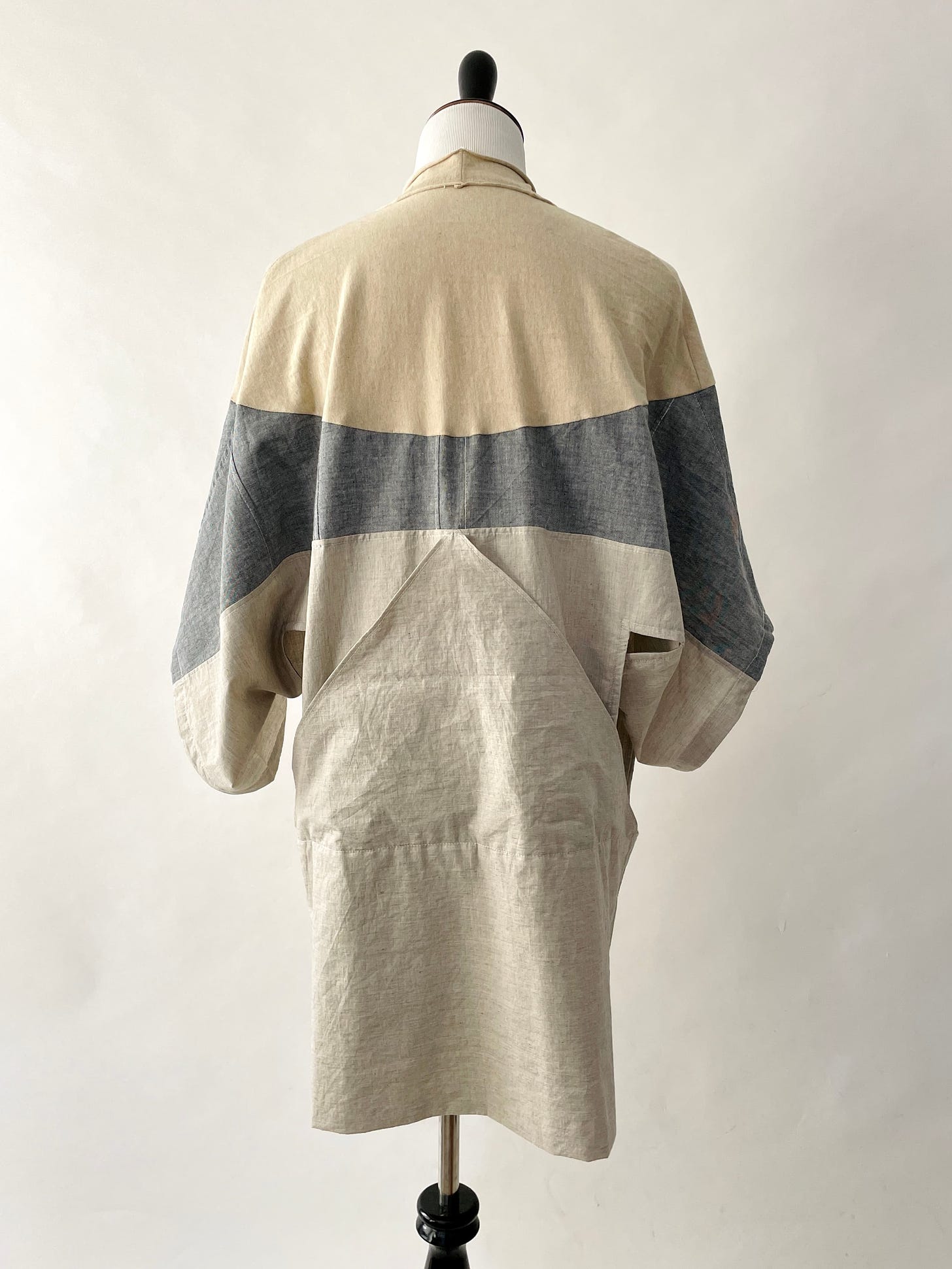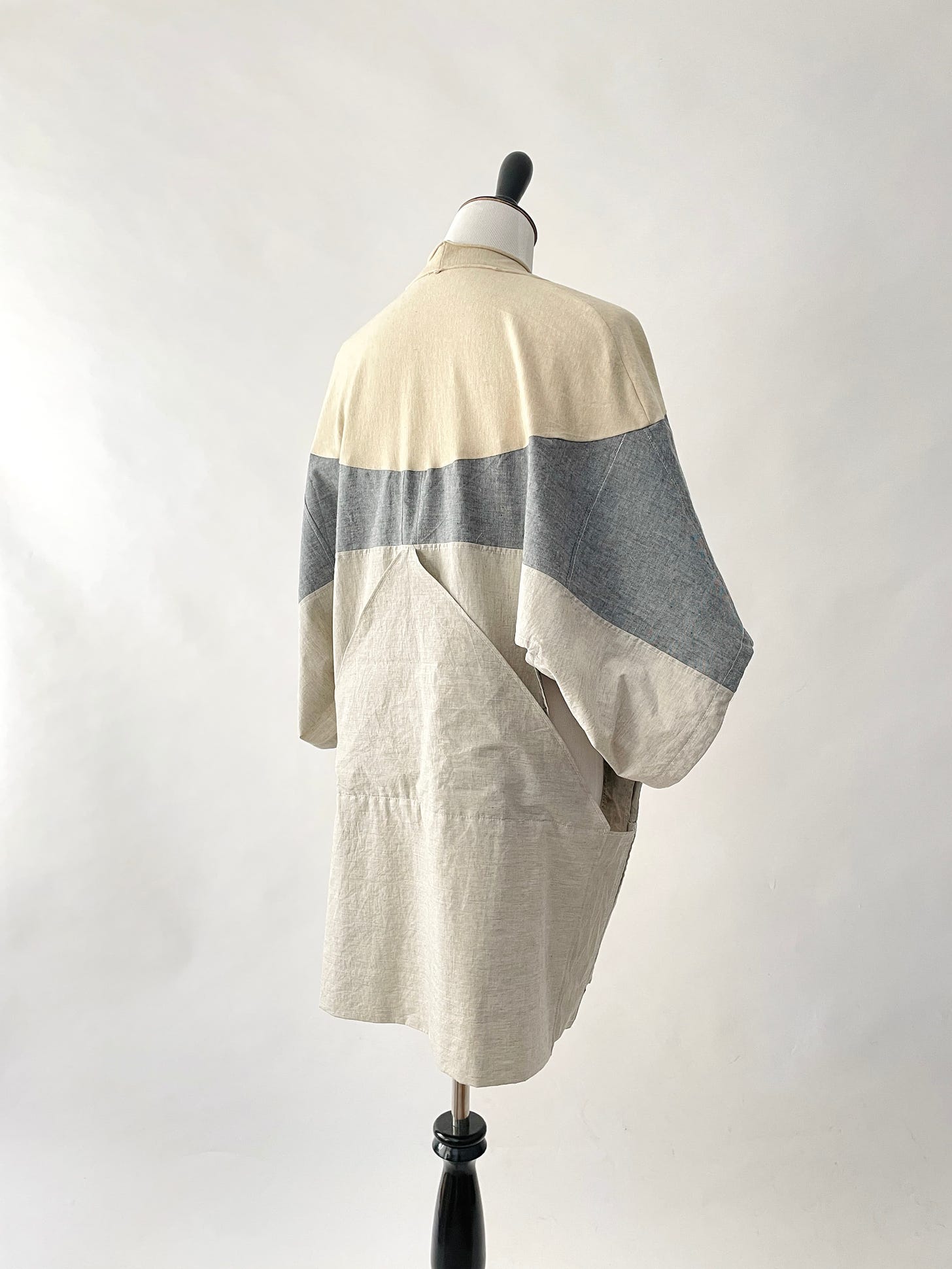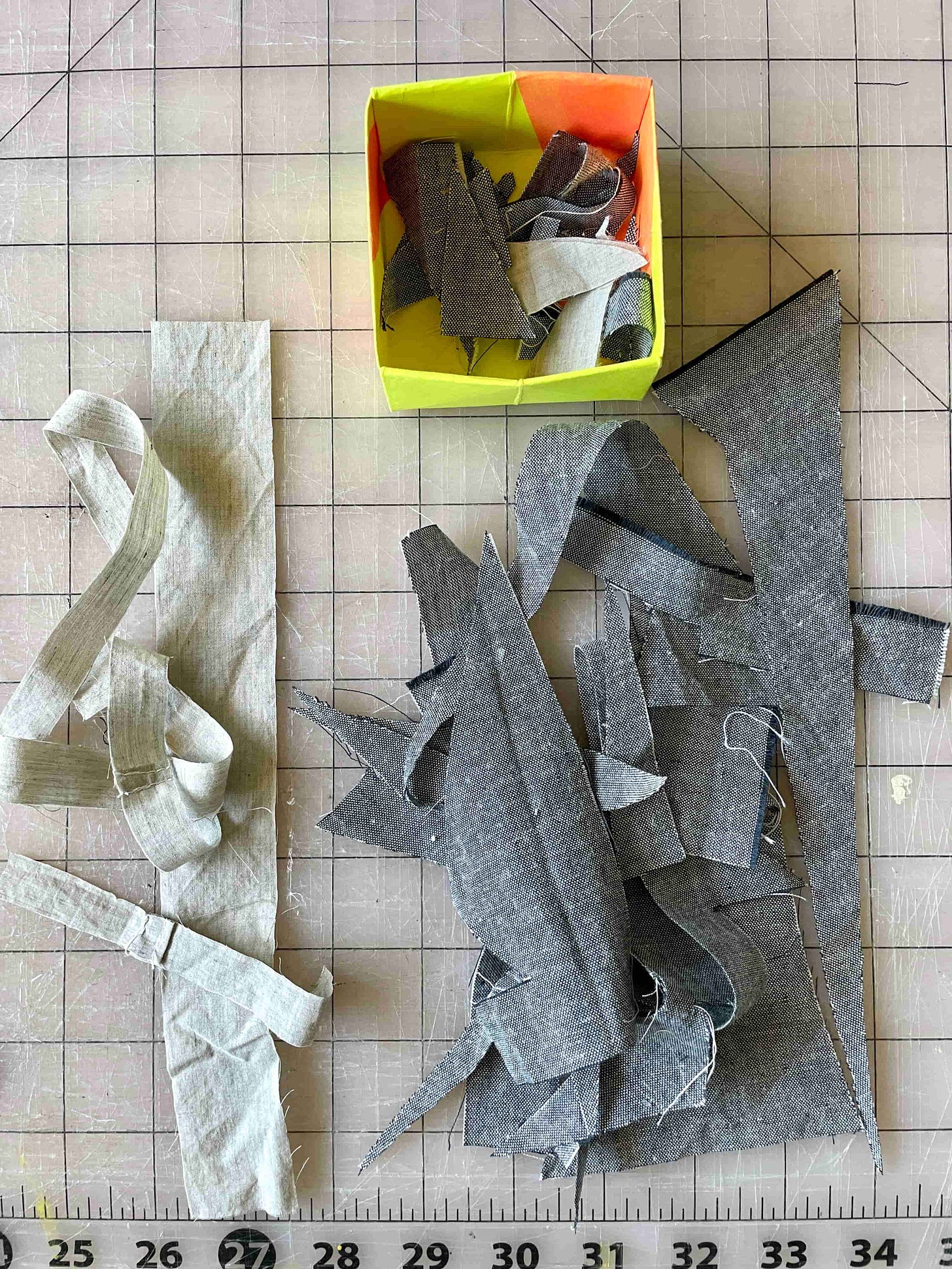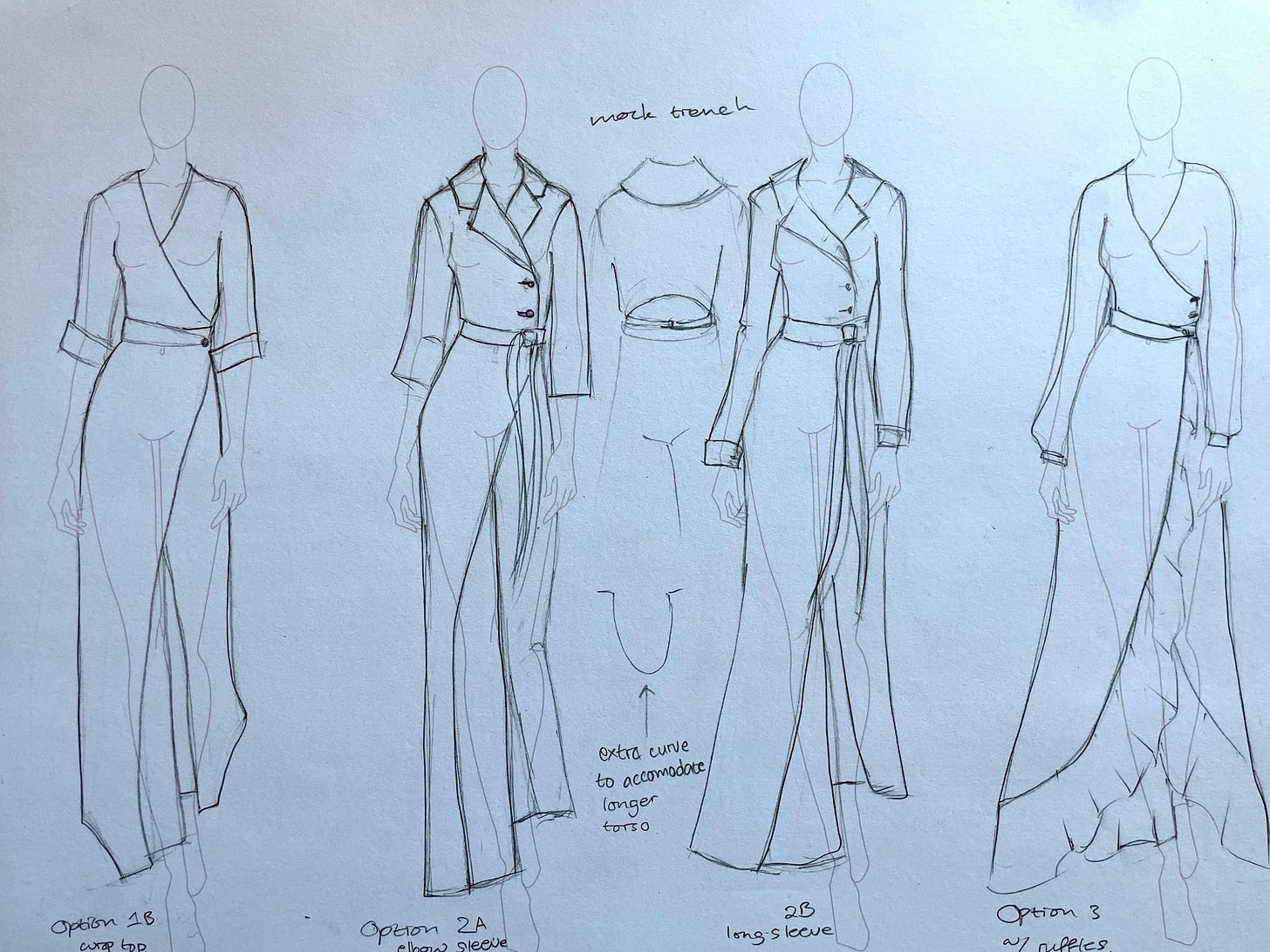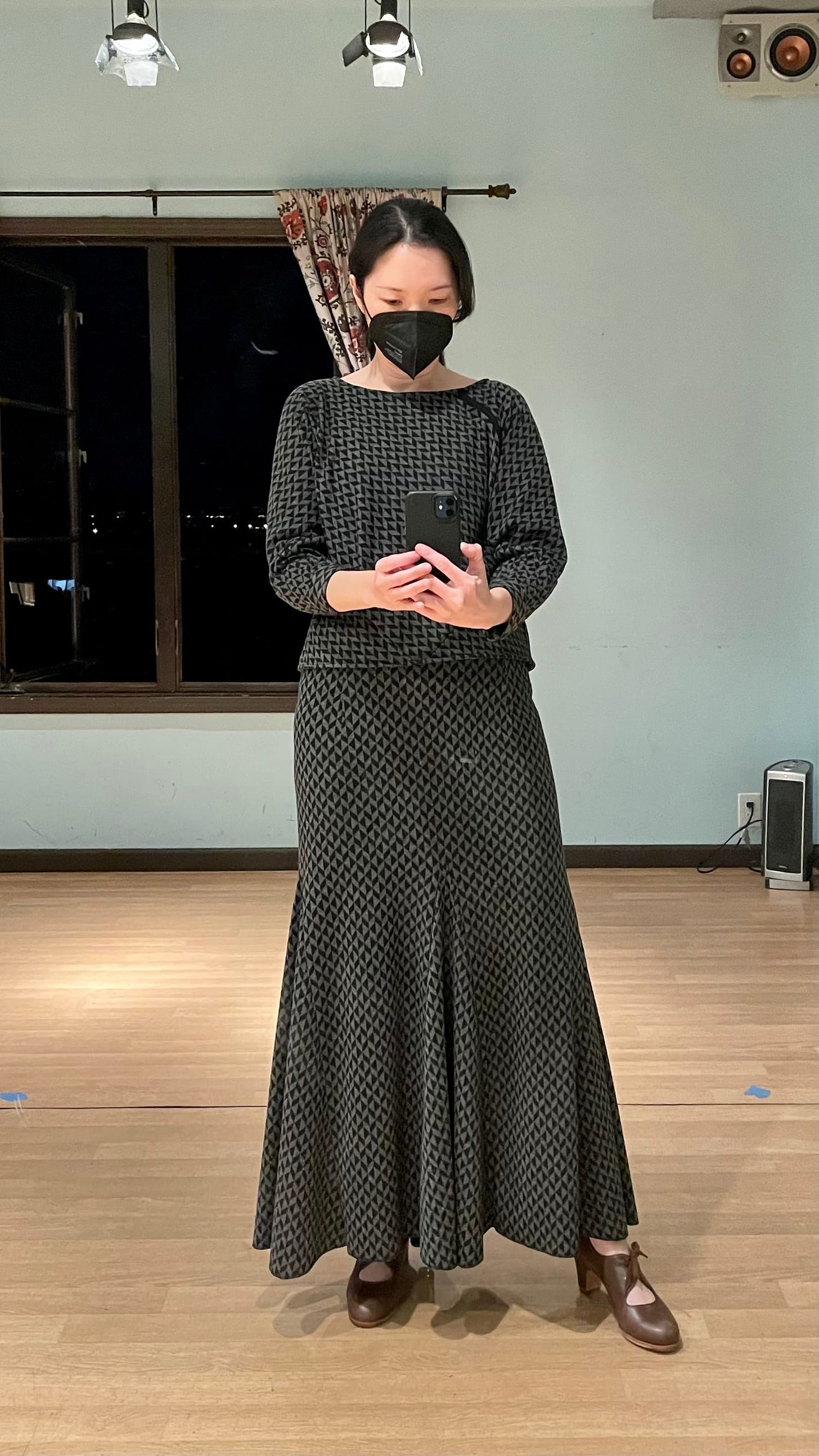First thing first: my artist showcase event is only two months away.
Wow. Just writing that sentence sends chills down my bones. I’m both exhilarated and terrified, so I hope you don’t mind seeing some of that chaotic energy seep into my writing this month. And next month. And the month after that. Gaah!
There is so much in-progress designing and making right now, and I will go over their highlights on this issue. Friendly warning: this is a long post, so let’s get to it!
There are two big topics for this month:
Behind-the-scene Design and Sewing progress for my October showcase!
Fibershed Design Challenge exploration: the journey continues.
Sew Much Preparations for October Showcase
Naming the Event
Last month, I made the first announcement of my upcoming in-person showcase as Climate Creative’s 2023 Artist in Residence. It’s going to be held in Oakland on Saturday, October 21, and RSVP information is now up. Get your tickets here!
Now, we finally have a name for this showcase. Envisioning the event’s concepts was much easier than coming up with a name. Thankfully my good friend, runway photographer extraordinaire Cynthia Anderson came up with the perfect name: “Hem and Jaleos: an Evening of Upcycled Fashion and Flamenco.”
Hem is a reference to hemline or hemming, a term that many people who love fashion and/or can sew recognize. Jaleo in flamenco refers to a word or phrase used to encourage the dancer(s), singer, or musician. For example, shouting “Olé!” during flamenco performances is a form of jaleos. Fellow performers give encouragement to one another, and the community members (in this case, the audience) are also invited to join the commotion to make the show more lively!
At the beginning of event conception, I envisioned rotating workshops, a live drawing, and a flamenco evening. Long story short: there were too many concepts to execute for a short period of time. It became more like a mini crafting festival that’s much more complex to execute than an artist showcase lasting several hours in a day. To be fair, dreaming big is one of my superpowers.
Back to reality, though. After getting more feedback from the community and more deliberation with Climate Creative’s Project Director Logan Evasco (she’s awesome, btw), we decided on two activities for this showcase: a live fashion drawing session, followed by a set of flamenco performances.
Fashion Life Drawing Session
There is a big overarching theme for my showcase. It’s about putting values back into “flawed” garments and textiles. Within the fashion life drawing session, I want to showcase ways to upcycle discarded remnants and cutoffs. They will be transformed into three custom outfits, each with a distinct topic and context.
One will be the 8th iteration of Gathered Cloths, one is going to be a mix of rib knit cutoffs and denim scraps, and the third one will feature diaphanous fabrics you may or may not seem familiar :)
I have recruited three amazing body and gender diverse models to wear these three outfits. With their help, I will hopefully compelling story about our textile waste reality.
Each model will hold a series of short (2 minutes), medium (5 minutes), and long (10 minutes) poses. The audience will be invited to sketch their observations on paper.
It’s a live figure drawing season! Drawing skills and expertise notwithstanding, everyone is invited to sketch and express themselves on paper.
As you probably have guessed, I’m still working on these outfits. Actually, I haven’t started yet. I recently gathered measurements from each model, and will be working on them next month after I’m done with my flamenco outfit workloads.
Speaking of which, let’s talk about that next.
An Evening of Flamenco Performance
Shortly after the drawing session, the audience will be in for a special treat! A set of flamenco performance, featuring renowned Bay Area artist Clara Rodriguez will commence. She will be joined by David McLean (guitarist), a singer (we are still recruiting), and three dancers (yours truly and two of her way-more-advanced flamenco classmates).
It’s likely that the dancers will wear a couple of outfits that night. I’m preparing to make a custom dress for Clara, something that she has never worn before but hopefully will love in the future. Below is an early sketch of a dress for Clara, titled a “Goudess” (i.e. Goudet Goddess.)
The silhouette is inspired by both a trapeze dress and a goudet, an extra piece of circular section fabric usually set into flamenco skirts to give the dancers a wider, dramatic range of skirt action.
I want to add alternative ways to wear the dress, and that’s where the fold-at-the-back option comes in. It’s inspired by Madeleine Vionnet’s design with rectangles in 1922.
While the silhouette most likely remains, I will most likely change the back details and how the dress is embellished. This is a necessary adaptation, considering the wearer will need to be able to slide in and out of the dress from below, keeping all of their beautiful hair styling and makeup intact and undisturbed.
But wait! There’s more sewing work!
How about the other dancers? Well, I’m glad you asked! I’m currently working to refashion elements of their outfits. I ask them to give me garment(s) they want to fall in love once again or make more flamenco. The most sustainable clothes are already in our wardrobe, right?
So in addition to making the Goudess, I will be refashioning several pieces for my fellow dancers. I will also most likely refashion a couple of things for myself. Hopefully, these previously flawed garments and fabrics can come alive again in the loving arms of their wearer. And the audience will see refashioned garments in motion during the live flamenco performance!
I’m prioritizing these projects over creating something for myself. If time permits, I also will refashion something for myself. I will most likely convert a bodycon dress into a flamenco costume and make a lace bolero jacket for one outfit, and refashion a polka dot top for a second outfit.
Seriously, it’s SEW MUCH.
P.S. In case you’re wondering, I keep track of everything I need to do with two documents. One is a Figma Jam file, where I brainstorm the concepts, define objectives, and distill activities. They also contain main tasks and timeline, as well as mapping of the performance space and perceived visitors flow on the D-day.
The other is an Airtable base, where I detail all tasks in sewing, event marketing, production crew recruiting, etc. It seems like a lot but believe me - they keep me sane! Perhaps that’s a story for another day… or month.
The Fibershed Design Challenge Journey Continues
Does the heightened work load for Hem & Jaleo showcase mean I can put the Fibershed Design Challenge on the back burner temporarily? Of course not! It’s better to keep the momentum going.
Last month, I shared the refashioning result of a 3.1 Phillip Lim x Target dress. In a way, it’s my warmup exercise for this challenge. I turned the process highlights into a couple of Instagram reels, so check out Episode 1 and Episode 2 of “Refashion Please!” if you are interested.
This month, I had an unexpected opportunity to make a couple of garments using regionally sourced cotton fabrics developed by Sally Fox. I was able to conveniently see and feel the fabrics before purchasing Sally Fox’s beautiful fabrics from Elaine at Kosa Arts in Oakland.
The two experiments end up being a win-win situation. I get to fill in the gaps of essential garments I need to have, develop first-hand experience with regional textiles, and create more experimental garments with zero-waste aspiration in mind.
Experimenting with Regional Textile #1: Brown organic cotton rib knit
The first fabric is 1.5 yard of Sally Fox’s organic cotton knit - Viriditas Farm Grown Brown Rib Vintage 2013. For this fabric, I choose to create a simple cocoon sweater. It’s a silhouette and shape that I have loved for a long time, and I was able to get a cheat sheet for the measurements on Pinterest.
I used to have a cocoon sweater in the past. It’s green cotton knit with some embroideries on the back, and I love it so much. I wore it so often and brought it everywhere, until one day I chose to pass it down. Now, 15 years later, I want to have something like that again!
I make the cocoon sweater carefully, doing my best to respect the cotton knit fabric. It’s sturdy, feels really nice to the touch, and has pockets! I’m really happy to add this garment to my wardrobe :)
Staying rather faithfully with the measurements stated on the Pinterest pin above, I end up with 2” x 6” leftover scrap - super close to zero waste. Technically, I could have made it truly zero waste if I used those scraps as additional reinforcement layers or hooks. But I choose to save these scraps for other uses.
Experimenting with Regional Textile #2: Green cotton lawn woven
Creating the second garment was quite a journey. It is made with 1 yard of Sally Fox’s fine cotton lawn woven fabric, some irregular Sally Fox’s beige cotton knit scraps that Elaine of Kosa Arts gave me, and less than one yard of charcoal chambray cotton fabric cutoff I have in my sewing stash.
The initial idea is to create a tunic with only Sally Fox’s cotton lawn and knit scraps. Almost immediately after, I want to add the charcoal chambray cotton in it.
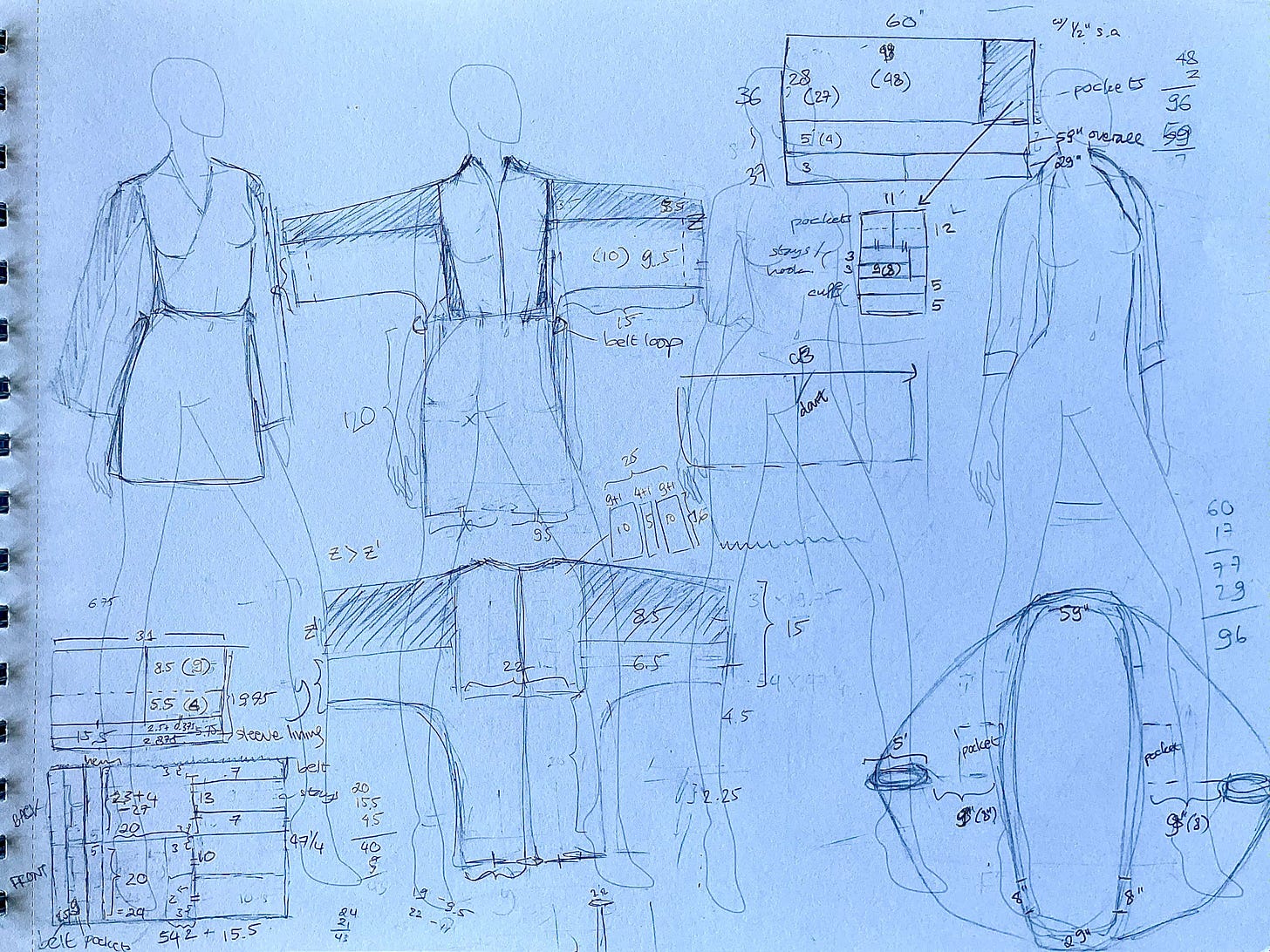
But after several nights fiddling with this idea, I realized that I did not love the initial design. I was prioritizing the method (zero waste) over my own needs. In other words, I was neglecting my own style preferences and features that are necessary to make me really love wearing this garment.
So before I did a second sketch, I worked directly with the cotton knit scraps on a dress form. From there, I knew that the beige knits had to be clustered around the neckline and chest area. Once that factor was nailed down, I started sketching again, incorporating folds into the new design.
For this experiment, I worked directly with the fabric pieces. No toilés or muslin prototypes. I was prone to make mistakes, and I was prepared to adapt as I go.
The first mistake I made was not matching the back and front pattern pieces for the top half of the sleeves. The sleeve curves had to be adjusted, and some slivers of charcoal chambray fabric was unnecessarily wasted. They were then reclaimed for future reinforcing projects.
The second mistake was not triple checking my measurements before cutting. Even though I made some in-scale paper models to check the overall design feasibility and simulations to finish the seams, this mistake happened a couple of times during the process. I had to adjust the design by half inch here and there to resolve the inconsistencies, and this delayed the project’s finish by several days.
After everything is said and done, however, the result looks… beautiful. Quite different from my original intention, it became more like a smock with open “windows” on the sides.
It features a harmonious color combination, neatly finished seams, hidden yet spacious pockets (YES!), gently staggered hemline from the back to front, and soft knit fabric that hugs the wearer around the shoulders and chest. The previously “flawed” charcoal chambray have now joined forces with Sally Fox’s fabric pieces, transformed into something valuable and precious.
And while my mistakes prevent this project from being zero waste, I’d say it’s not bad at all!
But Mira, how about your jumpsuit?
So you say. What jumpsuit?
I’m kidding. They are well and they have evolved a little bit. Last month, I did a mini product survey to reduce my own biases about jumpsuits and get community insights. I got 24 distinct responses and the takeaways are very helpful:
Comfort and adherence to personal style are two key factors for people loving their jumpsuits.
The typical pain points are fit issues around the torso (they tend to be too tight / structured) and difficulty to get in and out of.
Colorful patterns and bright colors are much less valuable than comfort, pockets, and ability to avoid stripping when going to the bathroom.
Simple, timeless designs are more preferred.
There’s a need to create jumpsuits for tall people (5’8” and above), where crotch tightness is a notable concern.
Even though the sample size is very small, I’m pleasantly surprised to see the number of people who self-identify as tall women responding to this survey. There may be a real opportunity there; maybe a pilot program can be launched in the future.
The biggest challenge will be price, naturally. More than half of the respondents get their jumpsuits from fast fashion stores, which directly influences their perceptions about how much clothes are typically worth. Can I challenge that perception by infusing thoughtful considerations within my textile sourcing and design process and turn that into real customer values? Time will tell.
Regardless, these insights make me sketch more options for the jumpsuit design. My favorite is option 2A, which looks more like a classic trench coat and pants than a jumpsuit. I wonder how it will be received.
Either way, there are quite a few factors to think through. And once my chosen regionally sourced fabric arrives, then the time to start executing the design vision will truly arrive. Until then, be well, everyone!
Parting Thoughts
In this issue, I talk about infusing value into what people see as “flawed” textiles. Flawed can mean many different things - cutoffs, discarded remnants, or clothes we no longer love the way we used to. For this month’s parting thoughts, I’m sharing with you a picture of myself wearing my flamenco pajama set during one of Clara’s sessions.
Flamenco and pajamas don’t make sense at first. Flamenco is a very high-energy, technically challenging, intense dance art form that takes years to learn and decades to improve and master. Pajamas are about calming yourself, getting comfortable, and being ready to relax and sleep.
As you can probably have guessed, these garments are made with fabric cutoffs. Beautiful, comfortable knit fabrics that have missed out on their chance to become part of a production batch. They eventually landed in my lap, and turned into a set of a flamenco practice skirt (made by my good friend Jesus Romero) and a matching 6-square top.
I love wearing them together to flamenco classes.
When classmates notice, I say, “Oh yeah, I’m wearing my flamenco pajamas tonight.” They usually laugh. What I don’t say is how nervous or unprepared I feel.
You see, I have learned flamenco for a little more than 4 years. Many of my classmates have been doing it for decades, and they are highly skillful in technique execution, articulation, and musicality. Combine that perceived pressure with the intense requirements of flamenco dancing, sometimes classes can be downright intimidating.
Even when I think my mind “gets it,” my body cannot execute it. It doesn’t move the way it’s supposed to, let alone mimic the fluidity and articulation of movements by professional dancers who started learning dance at a very young age.
So whenever I anticipate being overly nervous, unprepared, or just mind-wise exhausted from the day’s activities, I wear this flamenco pajama set to class. Not only do they look good and make me look put together, their softness helps me calm my nerves. Everything will be alright.
The previously flawed textiles now give me much needed reassurance whenever any challenging class begins. And for that, I’m thankful. Thankful for this textile’s flaws, thankful that it finds its way to me, and thankful that it becomes a valuable, comforting, encouraging presence in my life.
Thanks for reading; until next time,
Mira Musank





